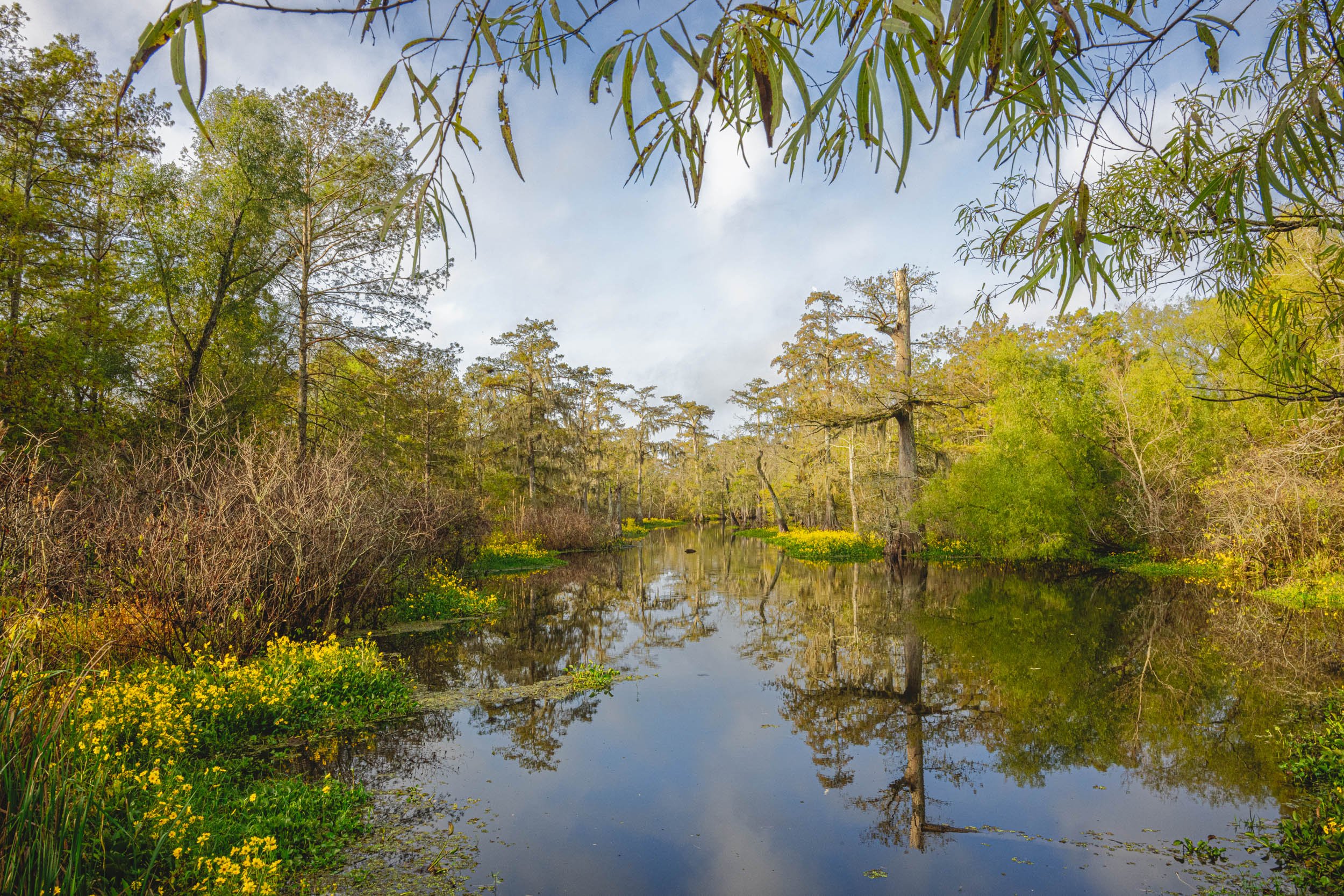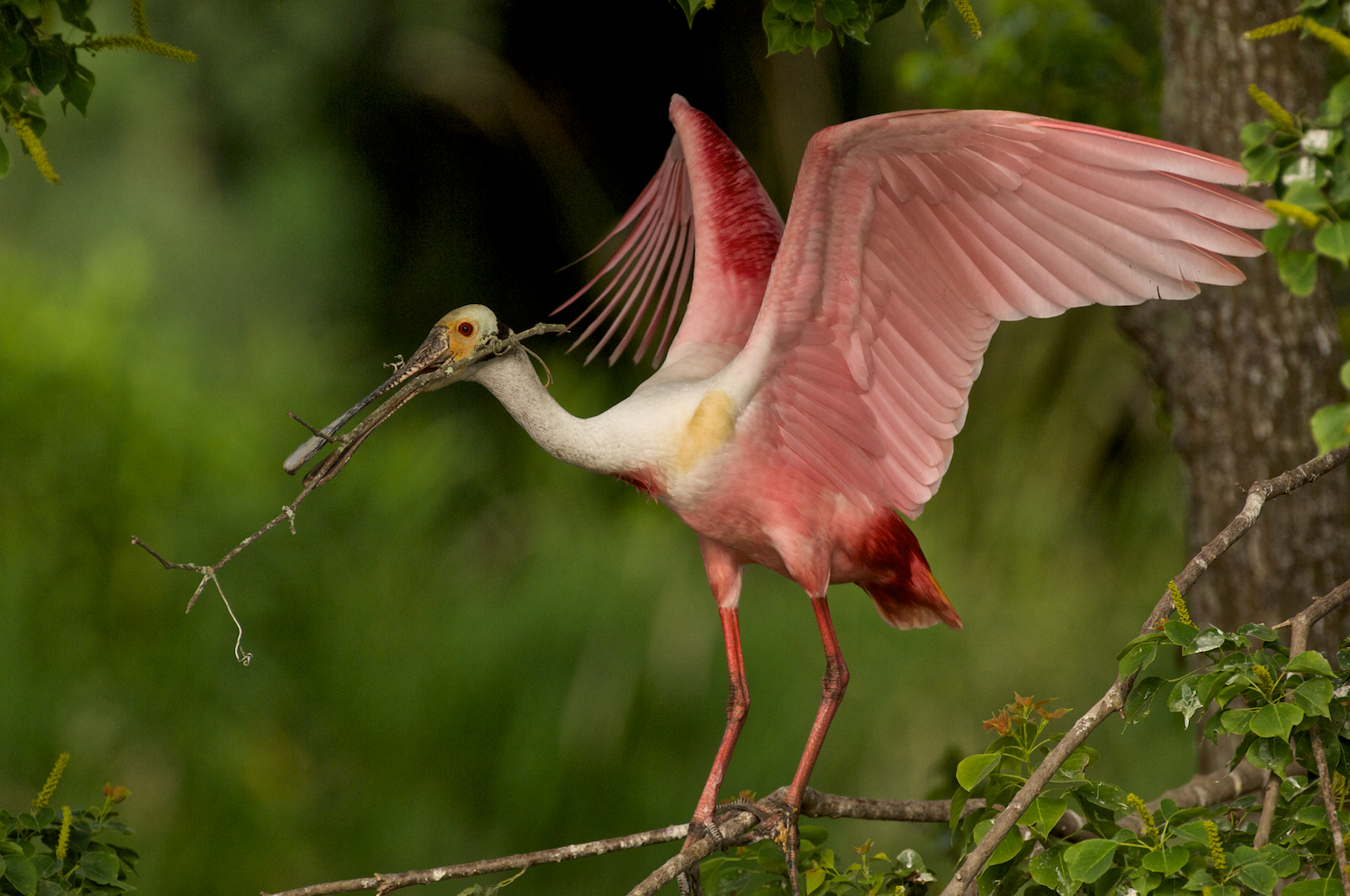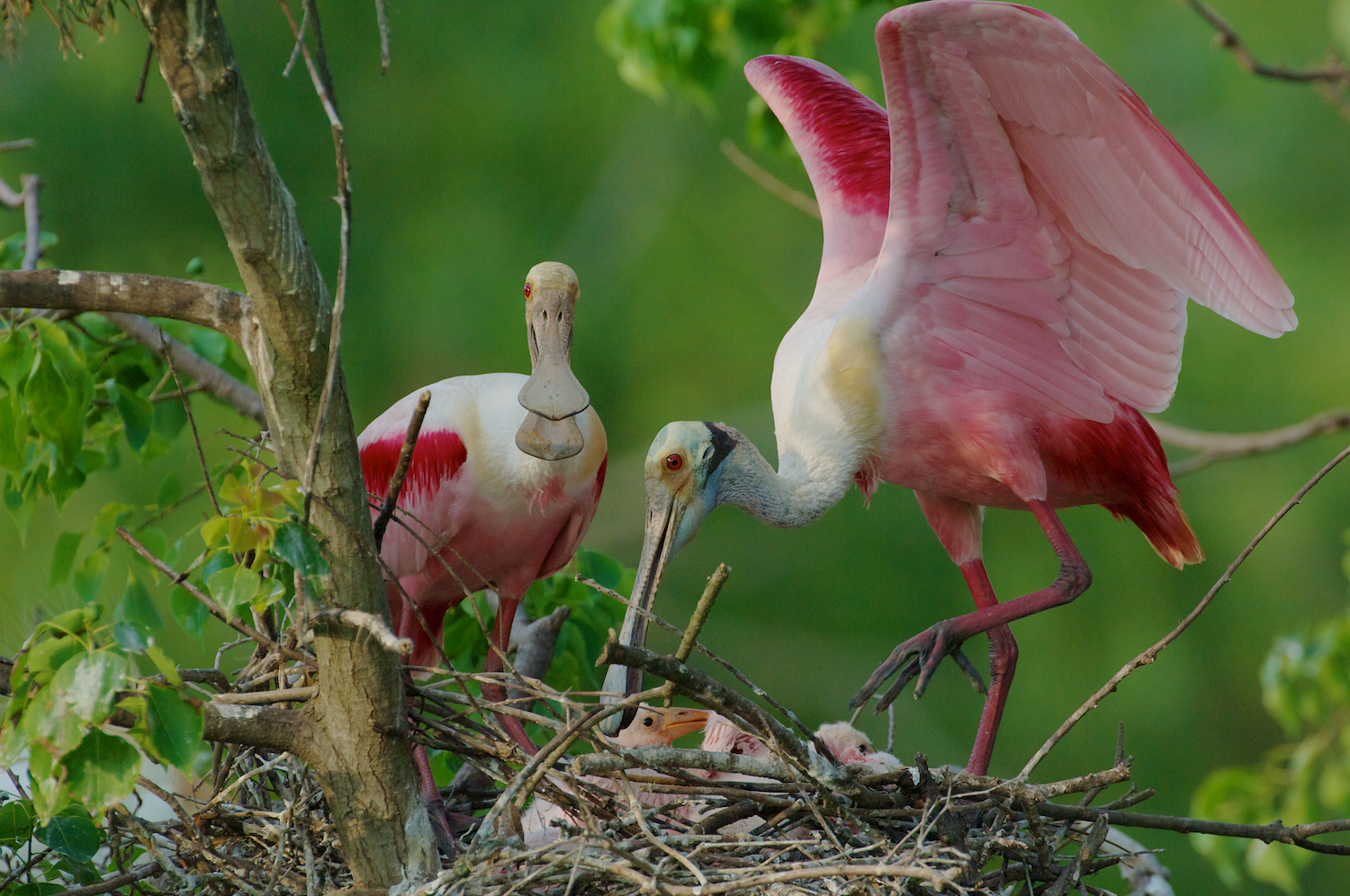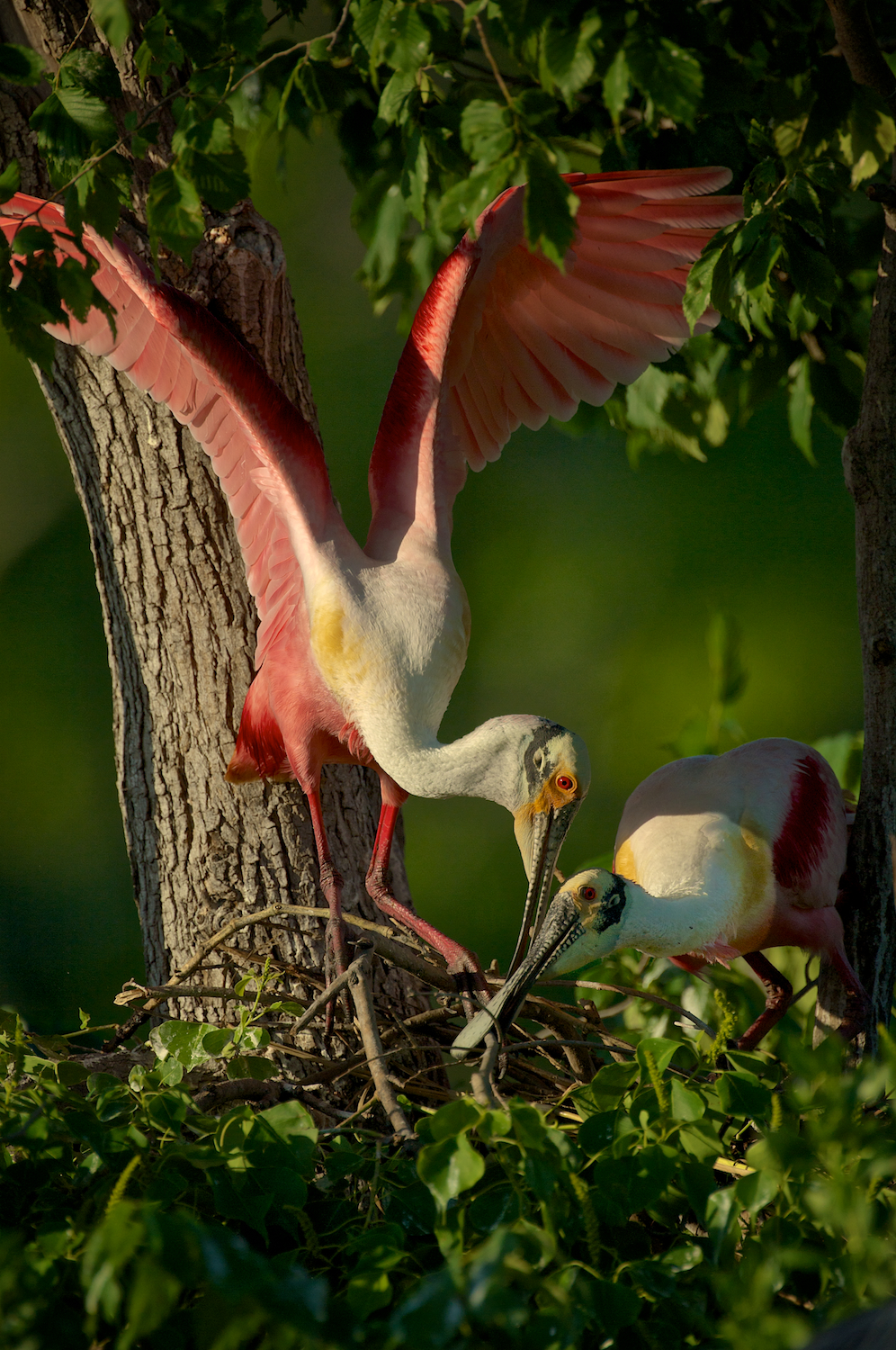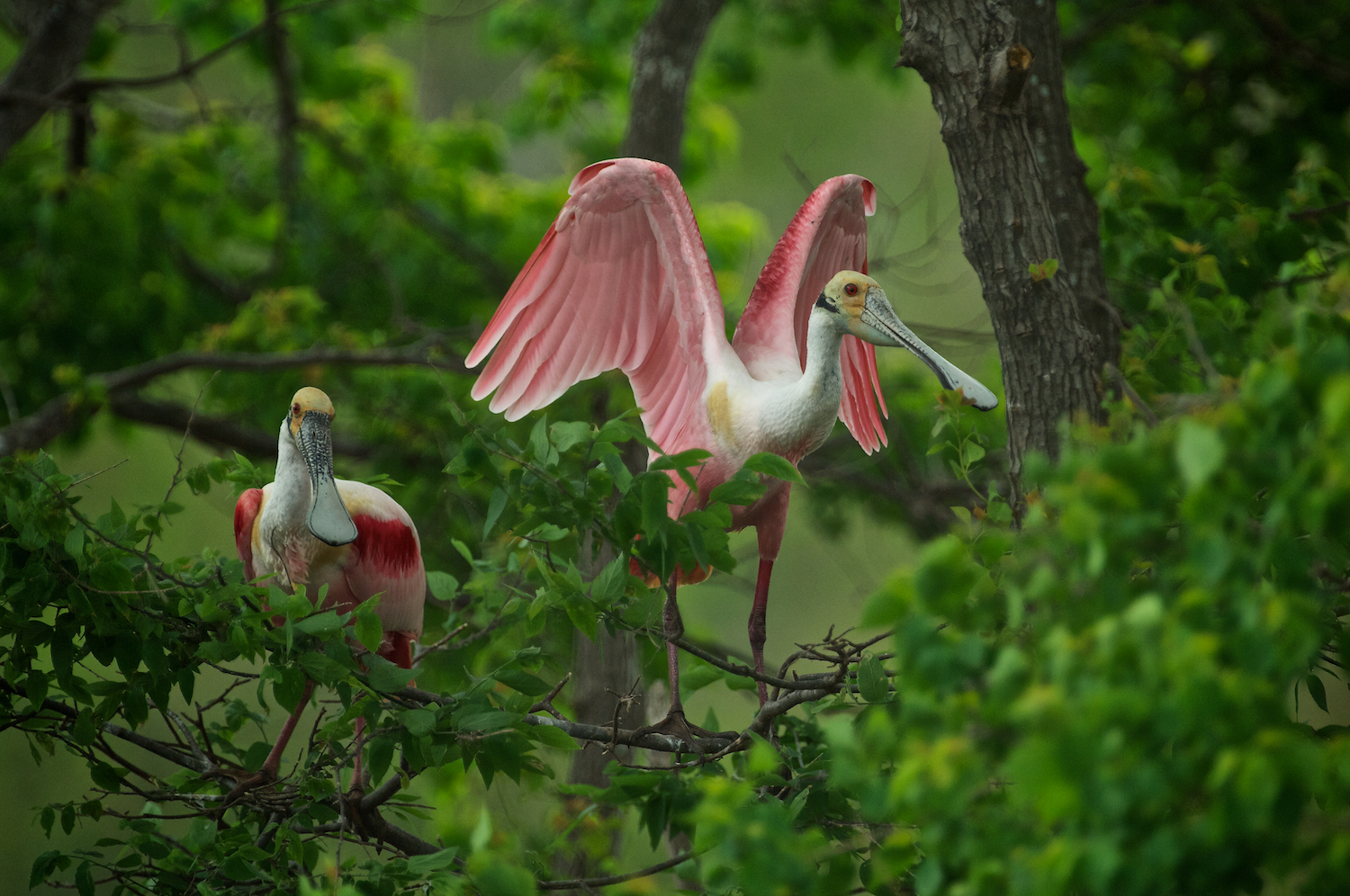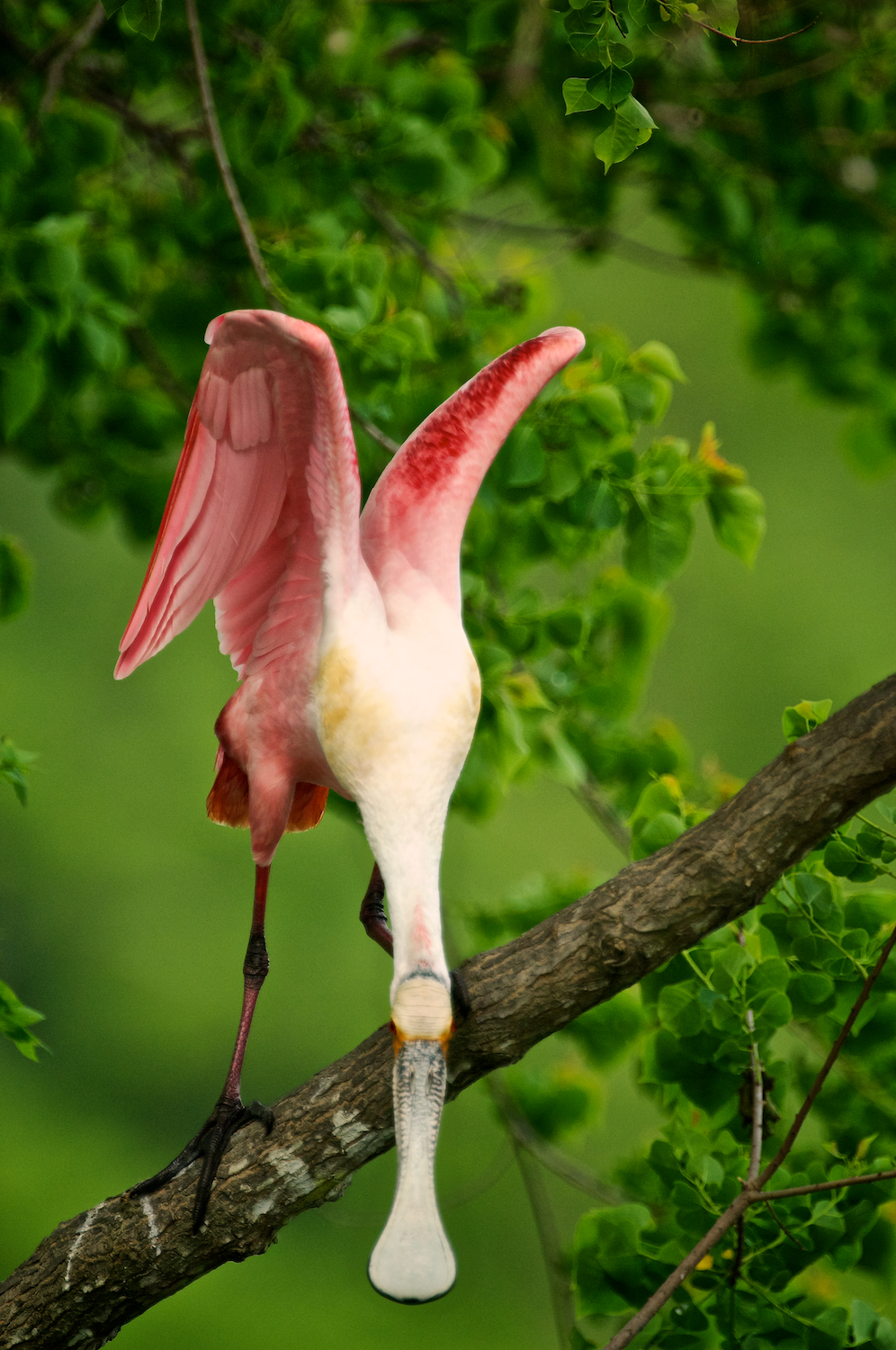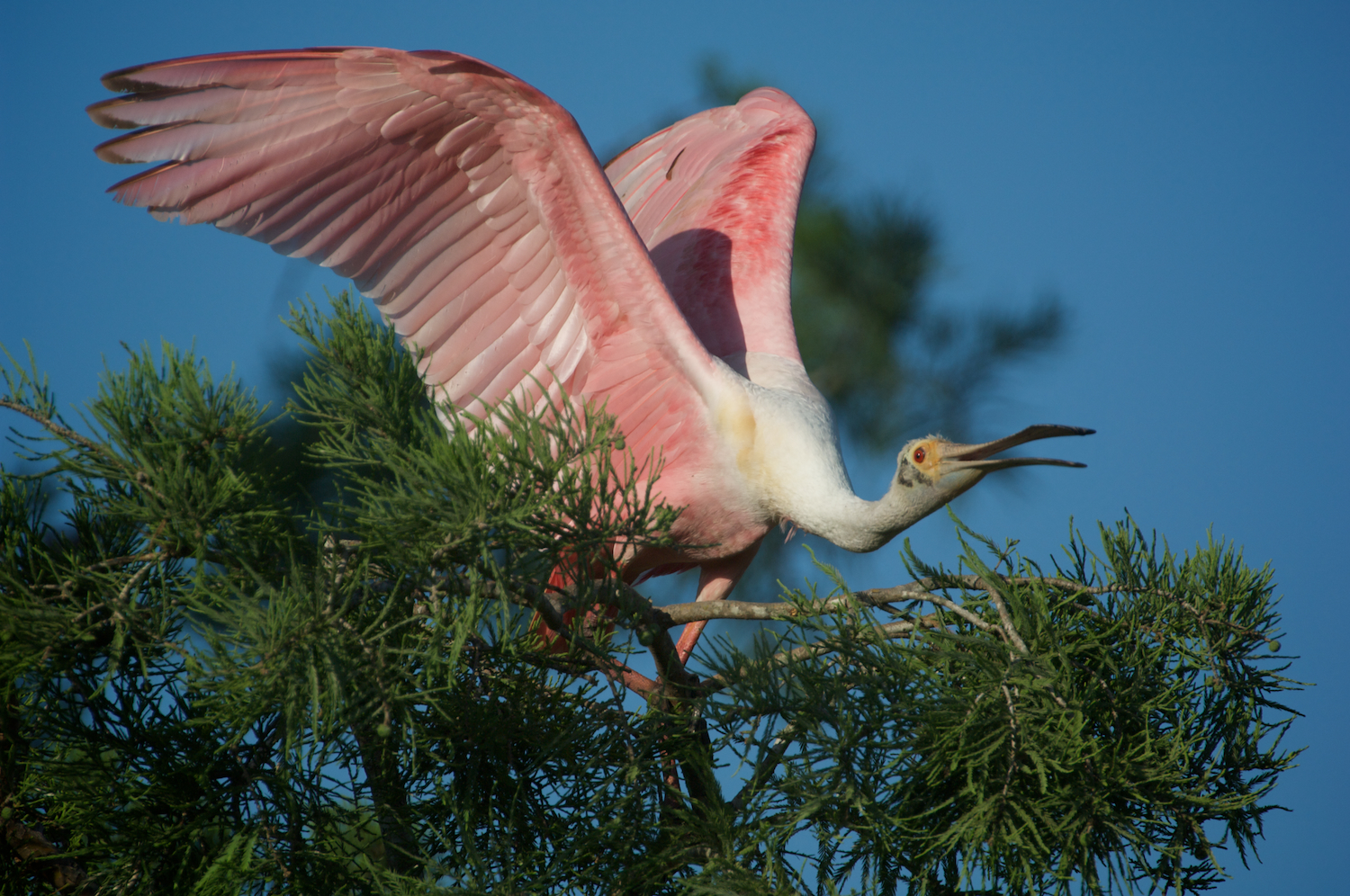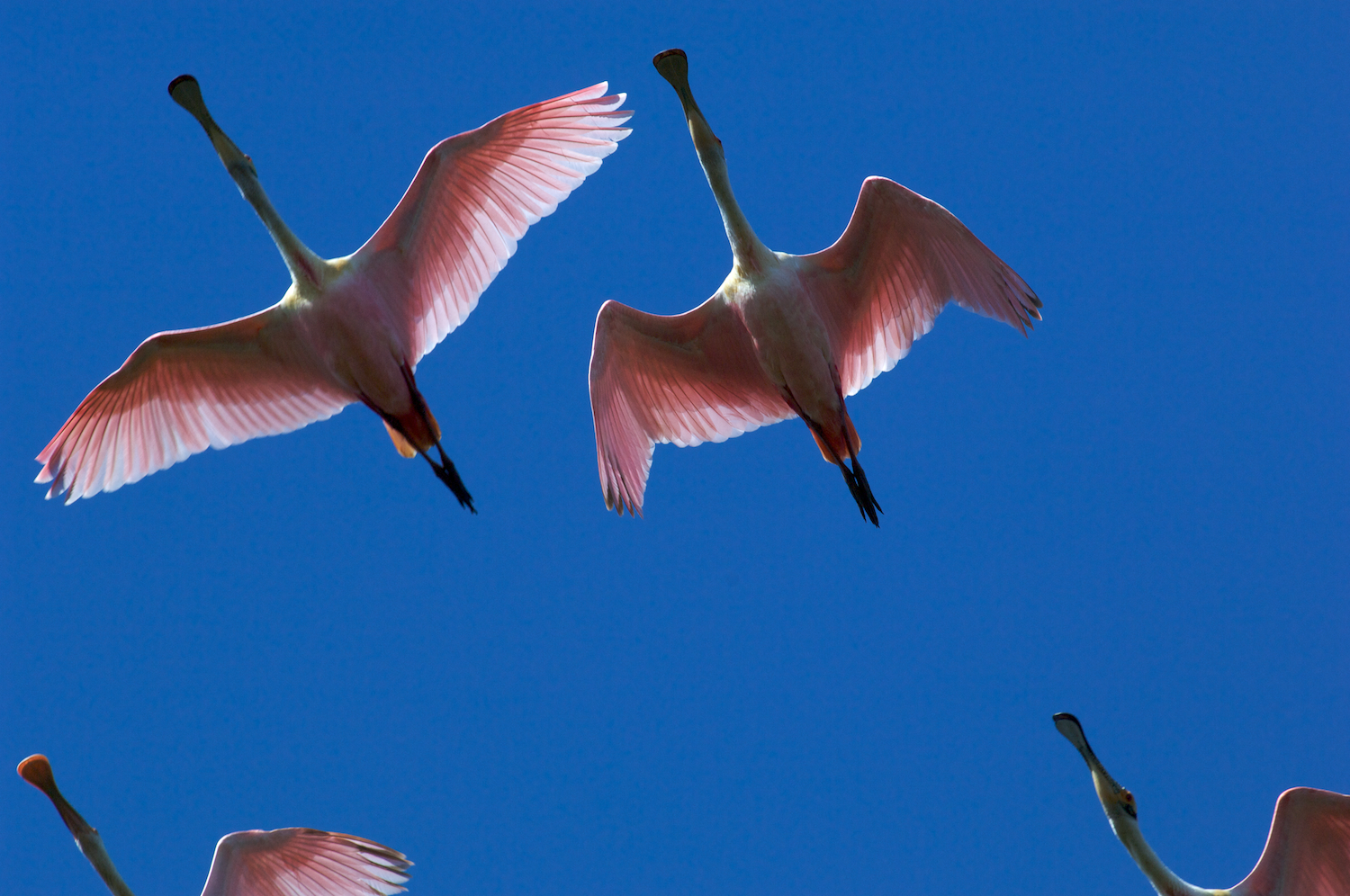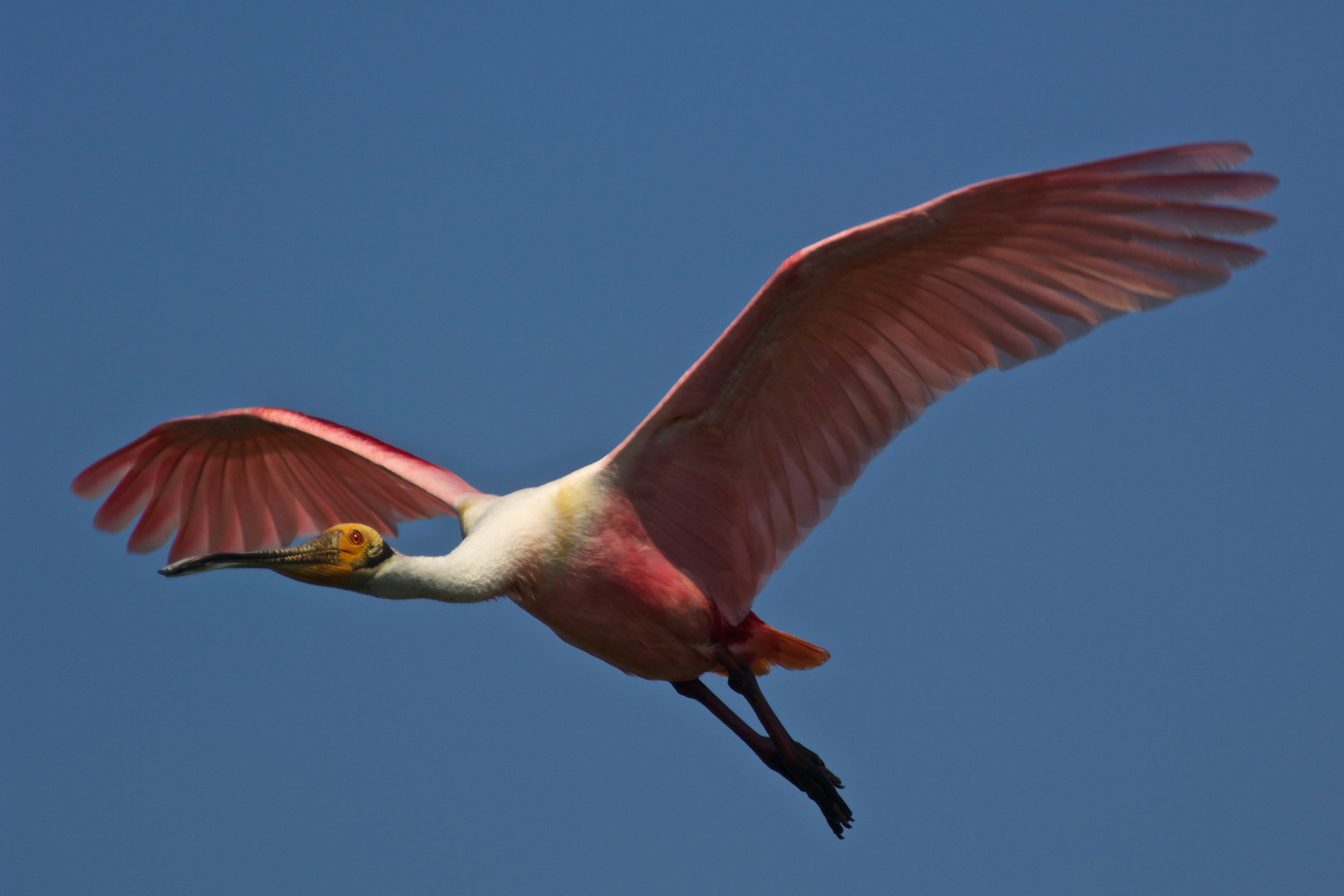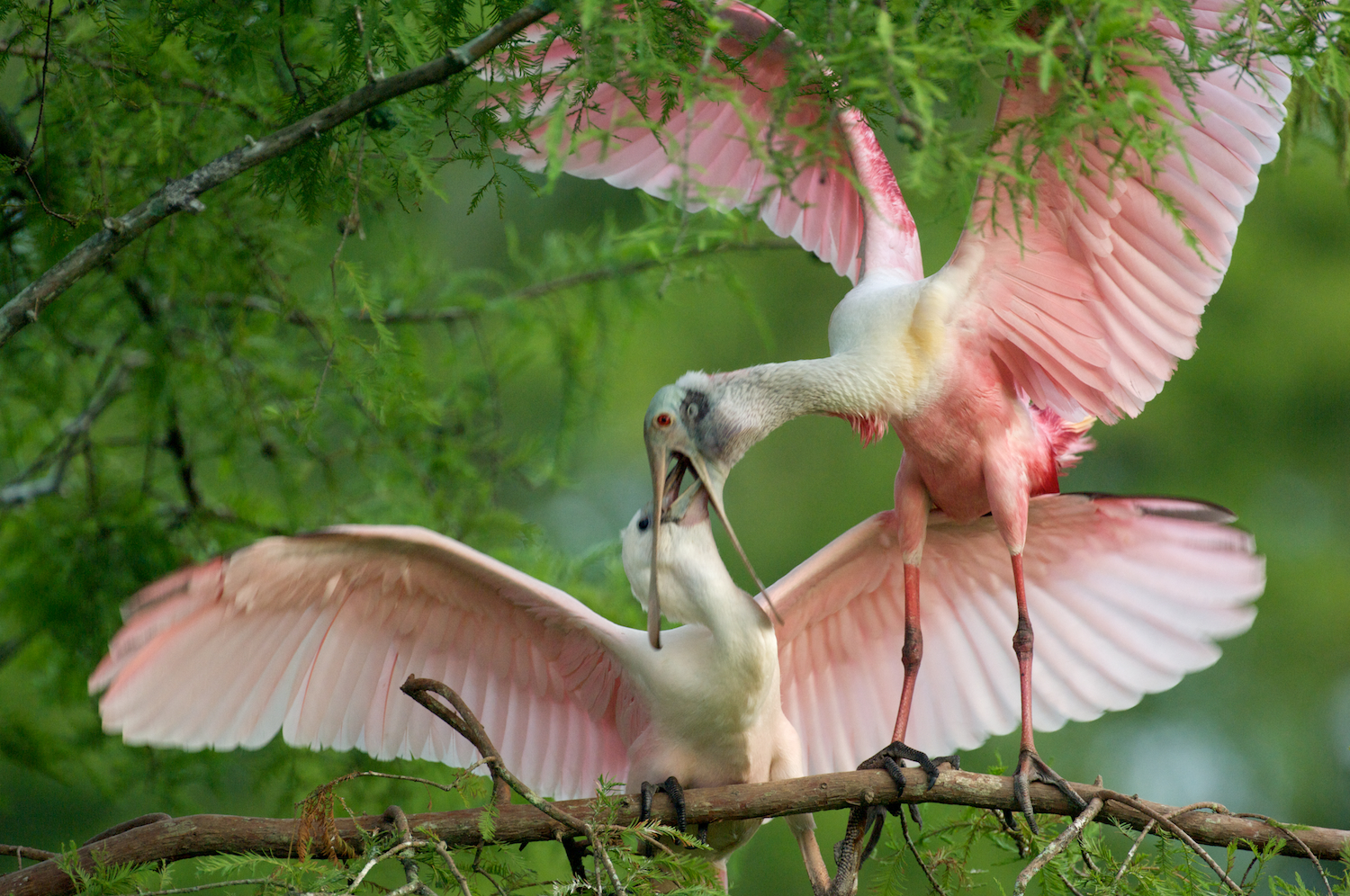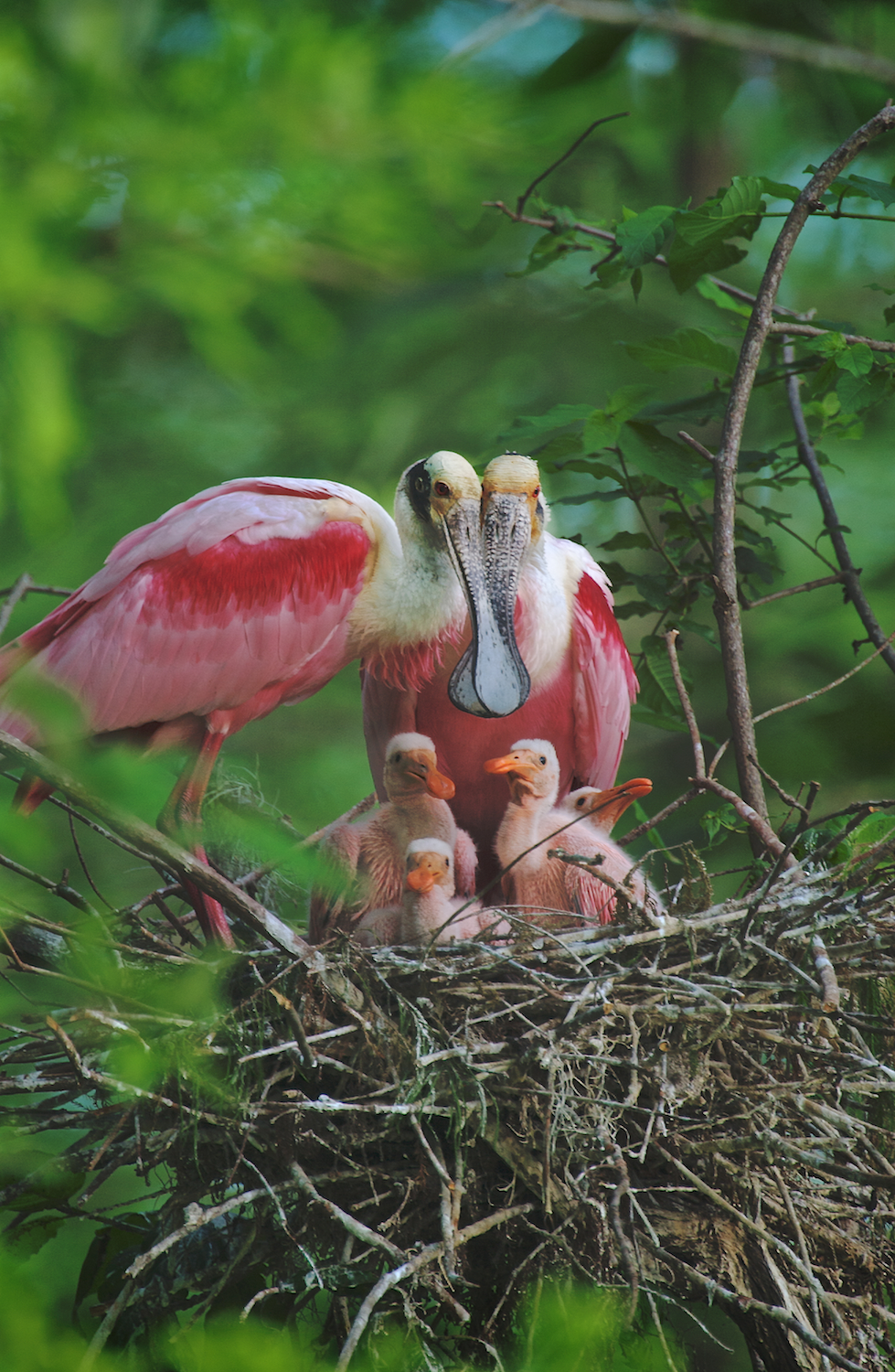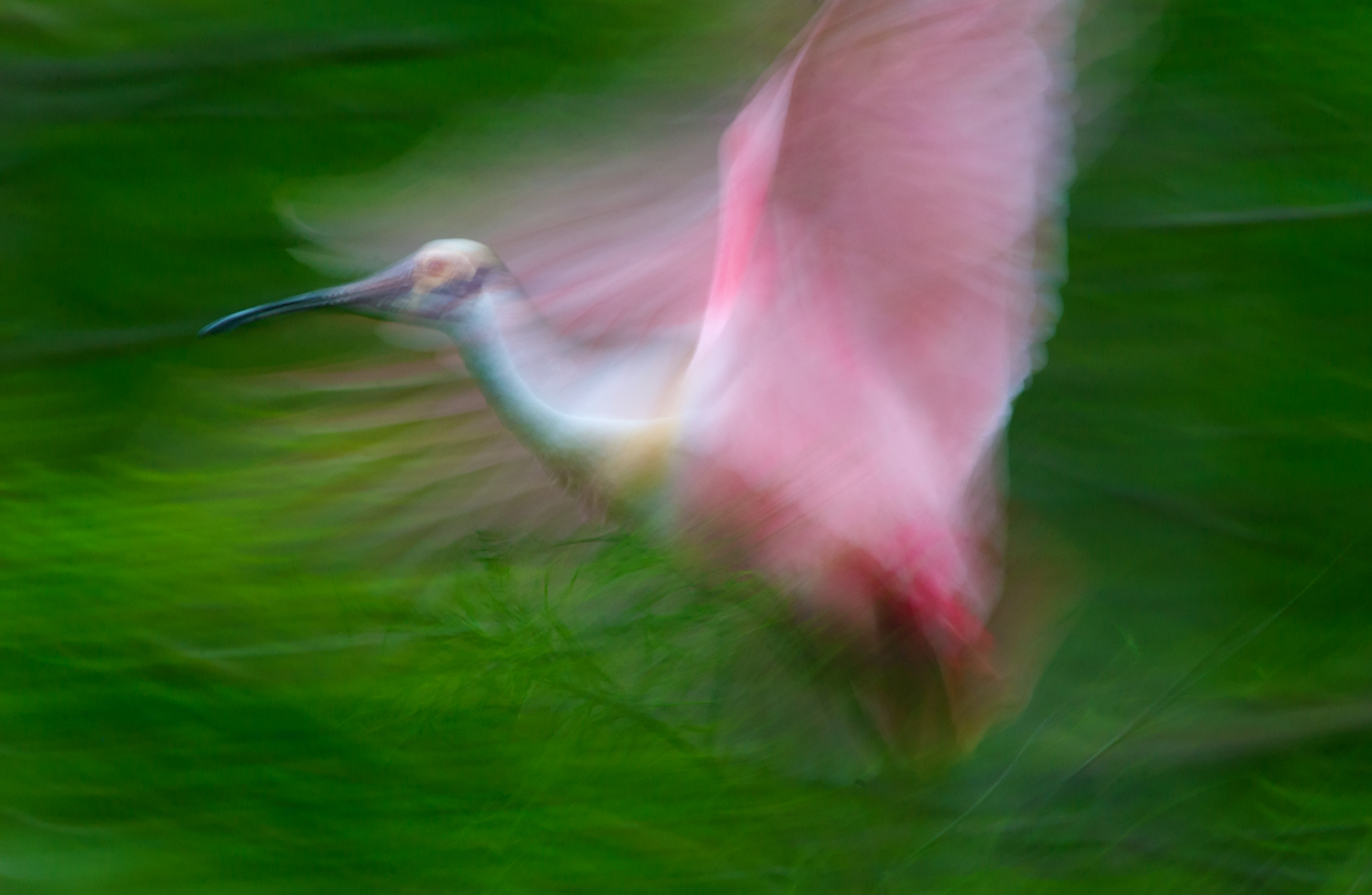Charles Bush Photography Newsletter – December 2024
Spring Bird Photography Tours: Now open for booking! Explore Cazan Lake, Miller’s Lake, Jefferson Island, Lake Martin, and Henderson Swamp while capturing nesting birds like egrets, herons, Roseate Spoonbills, and Osprey in flight. Includes three half days by boat and three half days on land.
Fall Tour Highlights: 2024 season concluded with spectacular imagery of autumn cypress trees. View the best photos in our gallery. 2025 dates to be announced soon.
Tool Updates: Insights from using Fast Raw Viewer and Photo Mechanic during fall tours. Detailed comparison coming soon.
Backup Strategies: Guidance for Apple users on the latest options for protecting your photo files. Blog post coming soon.
Thinking of Spring
Roseate Spoonbill at Rip’s Rookery Jefferson Island
As the year winds down, it’s the perfect time to start planning for spring! Our Spring Bird Photography Tours are designed to capture the stunning nesting wading birds of Southern Louisiana. You’ll have the opportunity to photograph majestic egrets, herons, ibis, the vibrant Roseate Spoonbills, and Osprey in flight in their natural habitats.
Tour Highlights:
Locations: Cazan Lake, Miller’s Lake, Jefferson Island, Lake Martin, and Henderson Swamp.
Structure: Three half days by boat and three half days on land to ensure a diverse range of photographic opportunities.
Learn more and book your spot today—limited availability for this unforgettable experience!
Great Egret Courtship–Cazan Lake
2024 Fall Tours Completed
Lake Martin early morning
Thank you to everyone who joined us for this year’s fall tours! The stunning cypress trees with their fiery autumn hues and the golden-hour reflections made for some incredible images.
Want to see the best shots from this season? Click here to view the gallery.
Looking ahead, the 2025 Fall Tour Dates will be announced soon. Stay tuned for updates in early 2025 and be ready to reserve your spot.
Sunrise at Lake Dauterive
Photo Mechanic / Fast Raw Viewer Update
I’ve put Fast Raw Viewer and Photo Mechanic through their paces this fall during the tours. Here’s a quick update:
Fast Raw Viewer: A fantastic tool for quickly checking exposure and sharpness, making it an essential part of my workflow. But it won’t replace Photo Mechanic as the import and keywording tools are lacking.
Photo Mechanic: Still my go-to for downloading and keywording images efficiently.
I’ll publish a detailed comparison soon, including insights from real-world use on the fall tours. Watch out for this on the blog!
Photo Computer Backup Strategies
Backup strategies are a hot topic, especially as we handle ever-larger files. I’ve been working closely with a client to develop a robust backup system tailored to photographers, particularly those using Apple computers.
New options, including improved cloud integrations and hardware setups, are making it easier to protect your images. I’ll be sharing these insights in an upcoming blog post to help you create a backup plan that works for you.
Stay Connected
Thank you for being part of the Charles Bush Photography community. As always, your passion for capturing the beauty of nature inspires everything we do. If you have questions about tours, tools, or techniques, don’t hesitate to reach out.
Happy holidays, and here’s to another year of extraordinary photography!
Warm regards,
Charles Bush
Bird Photography Equipment on a Budget
Bird Photography on a Budget
The equipment for bird photography can be very expensive. Part of this is the nature of the business, photographing small moving objects requires long telephoto lenses and effective autofocus systems
Beginning bird photographers would be well served with a good cropped sensor camera body and 400 mm f/5.6 lens or a 300 mm f/4 lens with a 1.4x teleconverter. By applying several common sense strategies you can acquire such a system at a reduced cost.
White Ibis in Breeding Plumage Millers Lake - Taken with Nikon D2X and Nikkor 300 AFS F/4 with TC-14e Teleconverter
This article is an update to my 2015 article, with much of it duplicated here. The good news is that with the switch by major camera manufacturers to mirrorless cameras with new lens mounts, there are bargains available for excellent systems. It is now possible to purchase a good starter system for approximately $1500, about $500 less than five years ago when I wrote the original article. The camera bodies now have more resolution, a faster frame rate, and are lower in high iso noise.
The equipment for bird photography can be costly. Part of this is the nature of the business, photographing small moving objects requires long telephoto lenses and effective autofocus systems Beginning bird photographers would be well served with a good cropped sensor camera body and 400 mm f/5.6 lens or a 300 mm f/4 lens with a 1.4x teleconverter. By applying several common-sense strategies, you can acquire such a system at a reduced cost. For Nikon, currently available suitable camera bodies are the D7200 and the D500, for Canon, the similar camera bodies are the EOS 7D Mark II and the EOS 7D Mark III.
Strategies for Reducing Equipment Costs
There are several strategies for reducing the cost of such a system. These include:
1. Buying Refurbished Equipment
2. Buying Last Years Model
3. Buying Used
4. Buying Grey Market
5. RentingBuying Refurbished Equipment
The two major camera system manufacturers used in bird photography, Nikon and Canon, both offer equipment that has been returned and then repaired and resold as refurbished equipment. I frequently use this strategy, and the savings are significant. Often the testing performed on refurbished equipment exceeds that done on new, I've purchased many camera bodies refurbished and numerous refurbished lenses, and I've never had a problem. However, one downside to this strategy is the length of the warranty, typically 90 days rather than the one year for new equipment, in some cases, a camera store will supplement the warranty with one of their own, but I'm not sure how well this works. I make sure I do a thorough job of testing any equipment purchased in this way as soon as I receive it to reduce the risk of a problem. Here are links to sources of refurbished equipment:
- Nikon
- Canon
- B&H Photo Video under the used tab select refurbished
- Cameta Camera
I have purchased refurbished equipment from Nikon directly, B&H, and Cameta Camera (Currently offline, not sure of their status).
For example, right now, Nikon USA has a refurbished D7200 699.96 and a D7500 for the same price, I'd choose the D7200 even though it's an older camera because it only has one card slot. Older, Nikon manual focus lenses aren't supported, if those things aren't relevant to you, the D7500 may be better as it shoots 8 FPS versus 6, and it has an articulating screen. A new D7500 is going for $899.99 on the same site.
Buying Last Years Model
Both Nikon and Canon have recently released mirrorless cameras, with significantly higher prices, and they probably don't handle flying birds as well as the DSLR's. For now, if you're looking for a budget system, I'd go with one of the DSLR's
The newer Canon 100-400 is $1799 at B&H, and the Nikon 300mm f/4 pf is $1996.55. While these are indeed very lovely lenses, for the budget-conscious, the older lenses are a better choice.
Buying used
Frequently when new equipment is released, people sell their older models to finance the latest camera equipment. This behavior is certainly correct now with the Nikon and Canon Mirrorless systems and with many people moving to Sony or Olympus Mirrorless systems. Looking at sources like KEH camera and eBay, you'll notice used camera equipment prices are much lower now. For example, I saw a used D500 on eBay for $845, which sells new for $1496.95. However, on eBay, if something looks too good to be true, it probably is. Check the seller ratings carefully and stick to one that has a high rating and a large number of sales. Usually, you're better off going to someone like KEH or the used department of B&H.
Buying Grey Market
Another strategy is buying "imported" or "Grey Market" equipment. Stores often purchase equipment outside of the country at a lower cost and then sell them in the US for less. The downside of this is that Nikon and Canon in this country will not honor the warranty or even service the equipment. I'm cautious not to buy any expensive Grey Market products. However, for low maintenance items, for example, a teleconverter, I would undoubtedly consider Grey Market if the price were right.
Renting equipment
One strategy for a one time equipment need, such as for an assignment or to do a photo tour, is to rent the equipment. Several good rental companies rent appropriate equipment. Two I'm familiar with are:
Lens Rental is also associated with Lens Authority, which sells used equipment, and Lens Rental offers a rent to buy option where you can try the camera equipment and then convert it to purchase after you rent. One caution is to be sure that you either have insurance or purchase their protection in case something goes wrong.
Camera Company Deals
Nikon and Canon are also running many specials discounting older cameras they still have in stock. If you're interested in a specific model, be sure and check that the used or refurbished camera or lens is really your best deal.
Conclusion
You can put together a good beginner's bird photography system with roughly equivalent Canon and Nikon equipment now for approximately $1500, roughly $500 less than five years ago, and have a better system.
Photographing from a Boat
Living in Southern Louisiana, we are surrounded by water. Over 40 percent of the wetlands in the lower 48 states are within Louisiana. The crown jewel of Louisiana Wetlands is the Atchafalaya Basin. The Atchafalaya Basin is North America's largest swamp and has an abundance of wildlife. With all this water, a nature photographer in Southern Louisiana will at some point spend time photographing from a boat.
Photographing from a Boat
Living in Southern Louisiana, we are surrounded by water. Over 40 percent of the wetlands in the lower 48 states are within Louisiana. The crown jewel of Louisiana Wetlands is the Atchafalaya Basin. The Atchafalaya Basin is North America's largest swamp and has an abundance of wildlife. With all this water, a nature photographer in Southern Louisiana will at some point spend time photographing from a boat.
On my photo tours, we spend a lot of time on boats and to get the most out my tours it is important to know how to shoot from boats.
Besides the fact that many of the best photo locations are only accessible by boat, when photographing wildlife, it is often possible to get much closer in a boat without invoking the fright or flight response. In a boat we are typically much lower and don't look as large or frightening as when standing. We also frequently camouflage the boats to further disguise the human form.
However there disadvantages as well. The largest disadvantage is the lack of a stable platform. Motion caused by wave action makes making sharp images challenging. Closely related to this is the fact that due to rocking motion of a boat it is often difficult to maintain a straight horizon.
Another disadvantage is space limitations. Many of the locations we photograph in are only accessible by skiffs powered by outboards or betting yet air cooled "mud boat" motors. The Gatortail "mud boats" used by the folks at Atchafalaya Experience, can only comfortably accomodate three photographers with limited space for camera equipment.
Finally one must not overlook the risk of getting your equipment wet, either from rain you can not escape, or water splashing into the boat.
Getting sharp images
While it's possible to use a tripod on a boat, I rarely do, setting a tripod on the deck of a boat transmits all the movement directly from the deck to the camera through the tripod. When hand holding the camera your body acts as a shock absorber and is able to correct somewhat for the motion of the boat. Here are some tips to help get the sharpest images:
Use your body like a tripod. Cradle the lens under your left hand, grip it with your right. Keep your arms to your side and if possible rest your elbows on your knees.
Carefully squeeze the shutter button, think about walking on egg shells when you do it. Minimize any potential movement in the process of firing the camera.
Maximize your shutter speed. Think about the least amount of depth of field you can get away with and set your aperture to as wide a setting as possible. Increase your iso sensitivity to the practical limit on your camera. Newer cameras give great results even at iso 1600, this is a time to use the higher sensitivity and use noise reduction in post processing to deal with the higher noise.
Use Image Stabilized lenses at slower shutter speeds. However at shutter speeds above about 1/500th it usually won't be of much help.
If all else fails, think of creating intentionally motion blurred shots.
Dealing with space issues
When shooting from a boat I like to travel light. Usually I have two bodies, a wide angle lens, a med-range zoom, and a moderate telephoto. Using a long telephoto on a boat is usually unnecessary and very difficult to do. Since you can usually get much closer than shooting on land, it is very seldom you would need one anyway. Dealing with a lot of equipment on a boat simply leads to a high degree of frustration and a lot of missed opportunities.
Keeping organized on the boat and getting to what you need quickly makes the difference in getting the shot.
This is another reason not to use a tripod. Setting up a tripod takes a lot of space and if there are other photographers on the boat it limits what you can shoot, because they're always in the way and usually you're in their way as well.
If you must use a camera support, consider using a monopod instead of a tripod. While you still will be dealing with vibration and movement issues, at least you'll take a smaller footprint wish will be easier for you and the other photographers to deal with.
Dealing with the elements
A small waterproof case is a very good idea. Last year I had a couple of cases where water washed over the boat and got onto my equipment, no damage, but a good warning.
Carry a couple of very good pancho's. On our tours, the folks at Atchafalaya Experience are equipped with large military pancho's, on several trips we got caught in serious rain and the panchos kept us and our equipment dry.
Head for shore at any hint at a thunderstorm. A small boat on the water is quite a target for lightning. Don't chance it.
Carry a few black trash bags. I've often shot in the rain with a trash bag keeping the equipment dry.
Remember when you're on the water it feels a lot colder, high humidity and wind from the moving boat equals a low wind chill temperature. Even in the fifties dress in layers with a good Gortex shell as the outer garment. For my December tours, thermal underwear is essential on the boats.
Use professionals for running the boats
I use Atchafalaya Experience for my tours for the following reasons:
They have the right boats for the job. They have many boats and depending upon the shoot one may have an advantage over another. If we need to get in tight places they have the gator tails that will go almost anywhere, if it's going to be cold or may rain, they have a cabin boat (very good if you need to shoot high by the way). If we need a bit more stability or have a few more people, they have crawfish skiffs.
They know the area, they're out there all the time and know the subjects and where to find them. Many of the places we go to are well off the beaten path, knowing the area is essential, you really don't want to get lost.
They've worked with me long enough to know where I want the boat in relationship to the light and wind. It's to the point we don't even need to communicate that, they just know where we need to be.
They know how to get the boat as stable as possible.
If you're planning to shoot from a boat spend the time to search out the best service you can, it can make all the difference. I don't own a boat and really don't want to, there's a lot to it and I have enough to do with the photography.
So to summarize:
Don't use a tripod unless absolutely necessary. If you must use a camera support consider a monopod. Use good telephoto lens techniques and high shutter speeds.
Use Image Stabilized or Vibration Reduction equipment if you have it.
Prepare for adverse weather, waterproof case, panchos, and plastic trash bags.
Use a professional service that knows where you're shooting and how to work with photographers.
Don't take a chance with lightning, at any hint of a thunderstorm, go back to the dock as soon as possible.
Pack light, take only what you know you will use, not everything you have.
Leave your long lens behind, it will just get in the way and you rarely will need it. I've only used my 600 mm lens twice on the boats and was very disappointed with the results. Trying to aim a 600 mm lens with everything moving is an exercise in futility.
Remember it feels colder over the water, even with temperatures in the fifties, dress in layers and plan for temperatures at least 10 degrees cooler than air temperature.
Photographing the Roseate Spoonbill
I've moved this from my old Web site. While I've updated the images using a slide show rather than the original in-line images, the content remains the same.
I’ve updated this guide with new information about where to photograph these beautiful birds; see the update here.
Also, please consider joining us for a tour, which includes photographing these beautiful birds; check out my tours here.
Ever since I saw my first Roseate Spoonbills along the side of the highway many years ago, I’ve been completely mesmerized by the striking colors and prehistoric appearance of this large pink wading bird. Not knowing of the bird when I first saw it, my first impression was one of disbelief. That was over 35 years ago, but every time I see one, I’m completely amazed but what I see.
General Facts and Appearance
The Spoonbill is the most striking wading bird in North America. It has a pink body, with red on its wings, and an orangish patch on its tail. The bill is spatula shaped and is used to scoop up its food from the water. It's about 30 inches tall with about a 36" wing span. The reddish wing feathers are more prominent during mating in the spring.
Here in Louisiana, they mate in early spring, March or April, and have the chicks in May or June. They nest with other wading birds in Cypress Trees growing in the water. Each mating pair has 3 to 5 chicks. The chicks are much lighter in color, a pale pink.
During the 1900's the population was decimated with "plum-hunters". The feathers were used for such things as fans. Since they nest among other wading birds such as egrets, which were also hunted for their feathers, the population was also impacted due to the disturbance of their nesting area. Currently nesting populations are found along the coast in Texas, Louisiana, and Florida. In Louisiana the largest nesting populations are in the Southwestern part of the state, within about 100 miles of the Gulf coast.
Behavior
The birds are often seen walking in the water foraging for food with their spatula shaped bill. Unlike the herons, they walk in a crouched position and move their tail back and forth as they walk. When in flight, the hold their head straight out, flapping their wings relatively slowly.
The birds are very territorial, during nesting season male act aggressively to other males holding territorial fights and chasing other males from their nesting site.
Roseates are often found in flocks during and outside of the nesting period. When nesting they are observed leaving and returning in larege "Upflights" involving many birds.
Migratory Behavior
In Louisiana, Roseate Spoonbill's don't appear to migrate outside of the area. They do disperse from the nesting site, probably due to food supply issues, but are found in the general area throughout the year.
The best online reference I've found is at:
Cornell Universities Birds of North America Online
Places to photographe Roseate Spoonbills in Louisiana
Lake Martin
Prior to 2006 Lake Martin, near Lafayette Louisiana, was without a doubt the premier location to photograph Roseate Spoonbils. Every spring, hundreds of pairs of Spoonbills nested in the Bald Cypress trees growing from with the waters of the Lake. Many of the nests were clearly visible from the gravel road on the East side of the Lake. The nesting area extended almost a mile from the south side of the Lake. This made mornings in the Spring at Lake Martin an exceptional place.
I returned to Louisiana in late 2001 and visited Lake Martin for the first time in March of 2002. It was an unforgettable experience seeing the hundreds of these beautiful birds sparring for their place to nest. During 2002 and 2003, I made the 2 hour trip to Lake Martin 2 or 3 times per week in the Spring. Many of my best photographs of the Spoonbills were made during this period.
Unfortunately early in the nesting season of 2006 a series of unfortunate events led to the near collapse of nesting at Lake Martin. The few remaining birds were nesting within the interior of the Lake far from human view and camera range. My take on this unfortunate event is found elsewhere on this site. While there has been a steady increase in the nesting population each year, as of the writing of this article in the winter of 2011, the birds have not returned to the area near the road that led to such wonderful photo opportunities. Hopefully over time Lake Martin will be restored to its' former status. Until then photographing Roseate Spoonbills there is only a pleasant memory.
(Update Late 2015, 2015 saw the fewest Roseates at Lake Martin since the 2006 event. Unfortunately I believe hope for a return of the previous glory of the Rookery is not to be expected.)
Rip Van Winkle Gardens - Jefferson Island
In 2007 I found a very nice Roseate Spoonbill Rookery near New Iberia, Louisiana. On the grounds of a Commercial Nursery many pairs of Roseate Spoonbills can be found nesting on artificial islands in Cypress trees. The islands were created for the express purpose of attracting a Rookery during the 1980's and it took until 2005 or 2006 for this to occur. Being on private property it requires permission to photograph there, but upon obtaining the permission it is a very nice and accessible place to photograph the birds. On advantage over Lake Martin is that there shooting opportunities both morning and afternoon. This location currently provides the best opportunity to photograph the birds. The way the location is laid out, it is a very natural setting with nice foliage and opportunities to create pleasing out of focus natural backgrounds. Not only are their opportunities to photograph nesting birds, it is well laid out for photographing the birds in flight.
Talons Landing Road – Klondyke, Louisiana
In Southwestern Louisiana, there is a small Rookery with Roseate Spoonbills. While there aren't as many birds as the Rookery at Jefferson Island, There are a there have been a dozen or so nesting Roseate Spoonbills for the past 4 years. While the site is on private property, shooting is from a gravel road to the West of the Rookery. The birds are about 70 feet from the road allowing excellent afternoon photo opportunities. During 2005, the site was badly effected by hurricane rita and there were no birds at the site in 2006. The birds returned in 2007 and have been there every year since.
(Update Late 2015, While the birds were nesting there in 2015, the grass along side the road has now almost completely obscured the trees, good photography at that site was not possible in 2014 or 2015)
Millers Lake
There is a very large wading bird Rookery at Millers Lake near Ville Platte, Louisiana. While the site has largely Ibis, Egrets, and Herons, there is also a small population of Roseate Spoonbills. While I love photographing at the Lake, access is by boat only and during dry years, only with a "mud boat". Unfortunately the Spoonbills nest in trees that are inaccessible by boat. While I've made some nice flight photographs of Roseate's there, it is not one of my preferred locations.
Other
As you move further west in the state there are other Roseate Spoonbill Rockeries I am aware of by have rarely photographed at. Sabine National Wildlife Refuge, badly damaged by several hurricanes, is a well known place for the bird. In 2006 when the Rookeries at Lake Martin and Klondyke had failed there was a small Rookery at Lacassine National Wildlife Refuge accessible by boat, the only place I could locate for that year. Interestingly, that was the only year the birds were there.
Photographic Challenges and Techniques
Wading bird Rookeries are challenging places to photograph.
The closest you're going to get to nesting birds is 75 to 150 feet. In order to photograph birds of this size at that range you're going to need at least a 500 mm lens to get nearly full frame photographs.
In many cases you're going to need a teleconverter to increase your range, with its' limitation on both sharpness and aperture.
Rookeries are cluttered places, it's difficult to isolate one pair of birds from others and getting a clean shot without sticks or branches is a challenge.
Roseate Spoonbills are light colored birds and frequently you're dealing with darker color backgrounds, exposure is tricky.
The following techniques will help
Learn and practice good tripod technique with your telephoto lens. A proper tripod, tripod head, and properly holding the lens will help get sharp shots at slower shutter speeds. Work on holding your eye to the viewfinder, keeping your hand over the focus ring of your lens and squeezing, not jabbing the shutter button.
With a long lens with its very narrow angle of view, moving only a small amount will make a major difference with what appears in the background. Don't limit your movement to left and right, check higher and lower and backwards and forwards as well. Look for holes in the vegetation and angles to avoid the out of focus bird in the background.
Personally I like to manually meter using the spot meter function on my camera. For my shooting this works best for me. I meter something bright white near the birds I'm photographing, typically an egret at a rookery and set the exposure to something like 1 1/3 to 1 2/3 above mid-tone, take a couple of test shots and check I'm not clipping the highlights with the camera's histogram and go from there. Other people prefer to use the camera's evaluative or matrix metering system with Aperture Priority and you can get good results with that as well. However using this method often you will need to add some negative compensation, particularly if the background is dark.
Roseate Spoonbills typically look best in softer light Therefore it' best to photographer either early in the morning or late in the afternoon when the light is softer and directly pointing at the bird to minimize distracting shadows. On overcast days, you can often shoot most of the day, but try to compose your shots without the sky in the background.
Photographing the Roseate Spoonbill in Flight carries it's own set of challenges. One advantage is that they will often fly directly overhead and you can get full frame shots with a 300 mm or shorter telephone lens. However like any moving object you need to master panning with the subject. Given the slower action of the wings, it is less difficult to get a pleasing composition than with many other birds, but photographing in continuous shooting mode is frequently helpful. Exposure against a bright blue sky is typically pretty close with no compensation.
Time of year
The four years I photographed at Lake Martin, the timing was consistent and as follows:
- Roseate Spoonbill's arrive and begin Mating Behavior – 2nd or 3d week in March
- Nest Building – Early Apri
- Eggs on Nest – Mid to late April
- Chicks on Nest – Mid May – Early June
Since 2006 working at different sites and with a different weather pattern, I'm finding that many years are later. In fact 2010, with a very cold winter, nesting activity and chicks on the nest at Jefferson Island was a good month later than what I had experienced at Lake Martin. Nesting at the Rookery in Klondyke was a good 2 weeks earlier than at Jefferson Island, although still several weeks later than what I had experienced at Lake Martin. It's difficult for me to tell if the difference was due to the location, the weather pattern, both, or some other factors unknown to me.
Summary
The Roseate Spoonbill is one of the most striking birds in North America. There are great places to photograph the bird in Southern Louisiana. The best time to photograph the bird is during its mating and nesting season as the bird is at a predictable location and less startled by a human presence. The best time in Southern Louisiana is usually from Mid March through June. Photography at a Rookery can be challenging due difficult exposure metering considerations and the jumbled nature of the Rookery. But the efforts required will yield wonderful photographs.



